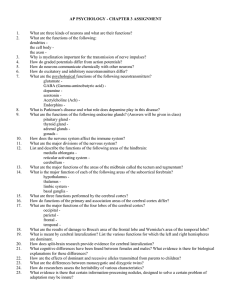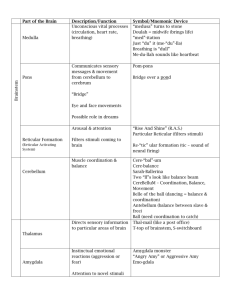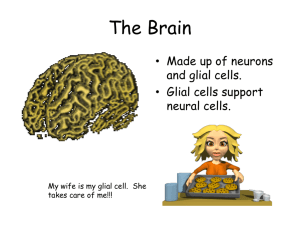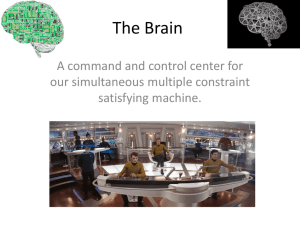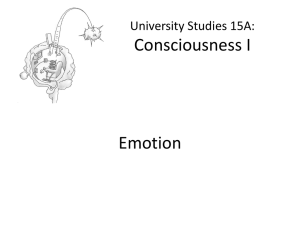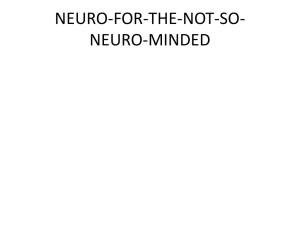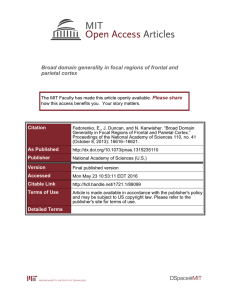ThePrimalTeenHODrTilton
advertisement
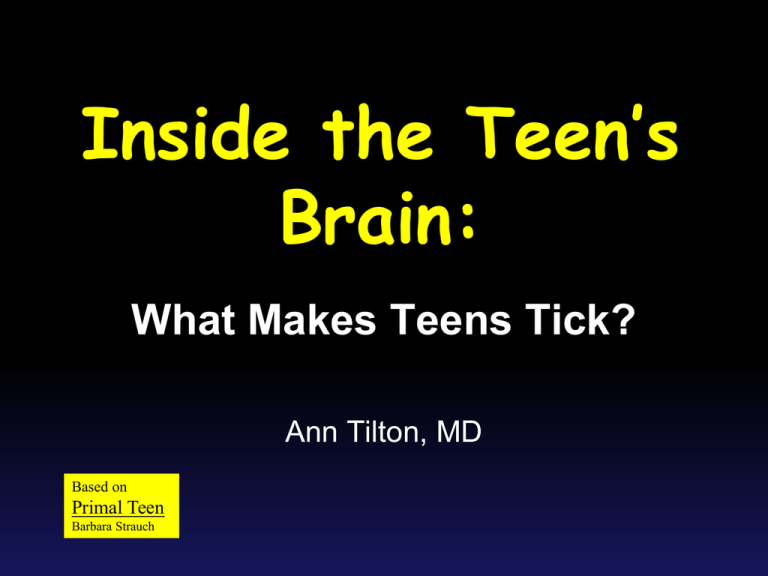
Inside the Teen’s Brain: What Makes Teens Tick? Ann Tilton, MD Based on Primal Teen Barbara Strauch Crazy by Design • Why do they do what they do? – Hormones – Friends –My fault…… – Brain What is going on? • Prior thoughts: – Brain was finished/cooked – 1st 3 years are the most important • NOT SO • Now: – Dramatic transformation – Stumbling block • Relatively few die • In animals “over in a blink” Study • NIH- Jay Giedd – 500 kids MRI for normals – Found the gray matter was thickening and then thinning (Nature and Neuroscience) – Areas • Parietal lobes • Temporal lobes • Frontal lobes What is Normal? • Frontal lobes synapses– by age 2 exceed adult levels 2X and adult level by 16-17- Huttenlocker – Confirmed by Chigani based on PET – More is not necessarily better (fragile X) • Prefrontal cortex develops until adulthood • MORE vunerable if exposed Altered States • Enrichment – Rats in a more complex environment have thicker cortex – increased dendrites • Deprivation – Romanian Orphans • Chigani - Less active in limbic area (facial recognition and attachment) Age of Impulse • Beat the Truck • Internet • Irresistible urge…… Age of Impulse • Pre frontal cortex – Limbic- gut and emotion – Separates humans • 29% growth • Chimps 17%, cats 7% – The great Inhibitor- teens are capable but do not have the breaks – Parents need to be the teen’s “frontal cortex” • In some cultures the child is an adult at 12 – ( in a very ordered society) Making Connections • Myelin jumps 100% in teen years – Good and bad • Growth especially in the cingulate gyrus and hippocampus – Gut reaction • Calm down– Decreased Glutamate Making Connections • World is seen differently – fMRI – Yurgeleu-Todd • Teen sees a picture of fear in a face – SEES ANGER – Social cues • Do not get it right Adolescent Animal • Rhesus monkey – Monkeys are better if raised by nurturing mothers and terry cloth mothers – Peer-raised have loose attachments – The males mature later – protective • Shy and offensive • Middle school Wake UP!! • Melatonin surges 2 hours later • Adults respond by: having them go to bed early and start school earlier • Sleep loss leads to: – Anger – Silly – Increased emotion Risky BusinessWhy do they do what they do? • Most do a few stupid things – Normal & necessary – Risky • 20% of 7th and 60% of 11th graders have had sexual intercourse • 10% drank weekly • Probably not “immortal” - just their own logic Risky BusinessWhy do they do what they do? • Neuroscience of risk – Use prefrontal cortex • Thrills: – Dopamine• Smooth movement and Pleasure – Reward circuit • Increased in – Videogames – Addiction / drugs THRILLS!!! • Novelty seekers – 50% heritable – Kennedy legacy – High – sensitive to reward – Low- safe except with alcohol • Dopamine decreases from childhood (except pre frontal cortex) – Teens are depleted THRILLS!!! • Addiction – Drugs - cocaine, heroin, nicotine, alcohol all increase dopamine • Overload down regulates dopamine Drugs • Alcohol – Alcohol in Adolescents is less sedating – 50% alcoholics traced to a gene related to the reward system – dopamine, serotonin, and endorphins Drugs • Alcohol – Rats • Damage to the hippocampus 10% smaller – With 2 drinks per day – More Problems with stopping drinking • With alcohol the NMDA-glutamate receptors are blocked – then more sensitive – Too much calcium is let in - cell suicide – Death in the hippocampus Drugs • Alcohol – Worse for teenagers • 2 drinks a day leads to 10% memory loss • Heavy drinkers (5 drinks in a row at least 1X in 2 weeks) – 30% 12th graders – 26% 10th graders – 14% 8th graders Drugs • Alcohol – Worse for teenagers who drink before 15yr • 5X more likely to be a heavy drinker • 10X more likely to be involved in a fight • 7X more likely to be in a car wreck Smoking • Smoking and Panic – If smoke 15X risk of Panic attacks • Nicotine mimics ACH – Esp in the ventral tegmental area where there are many neurons that produce dopamine • Produce 2X the number of receptors = leads to craving Smoking • Females – are more susceptible due to estrogen – Hippocampus damage • All – Lower serotonin levels which lead to depression – Prone to infections Schizophrenia • Theories: – Abnormality of Dopamine and GABA – Normally loose 15% of excess cortical gray matter • Problem with pruning- Schizophrenics loose 25% – Prefrontal cortex abnormalities Conclusions • Science continues to show behavior and brain structure dance in tandem Thought….. The Chinese symbol for Change is both Peril and Possibilities

